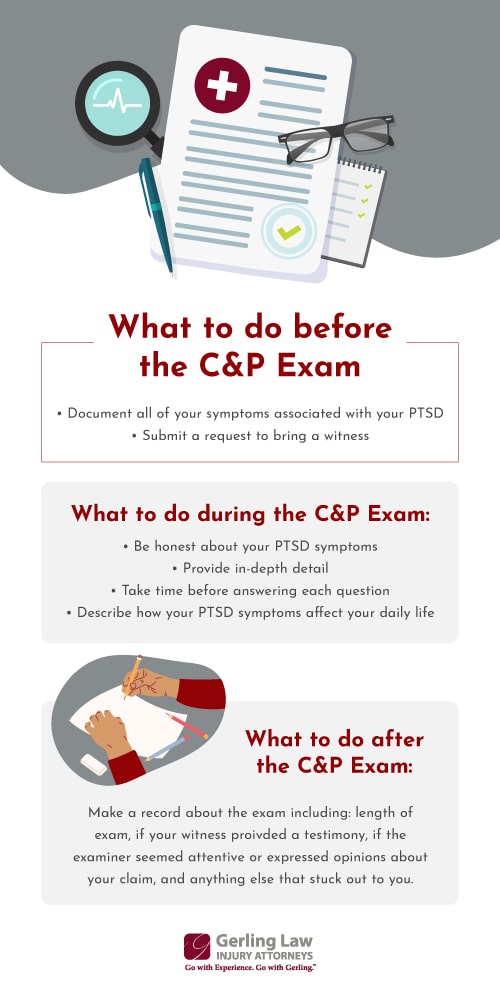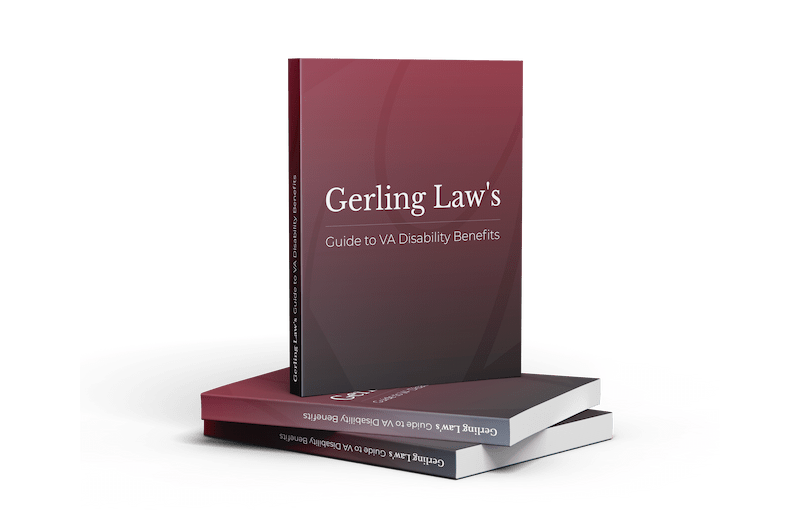What Is PTSD?
The U.S. Department of Veterans Affairs (VA) describes posttraumatic stress disorder (PTSD) as a mental health problem sometimes developed after experiencing or witnessing a life-threatening event, such as:
- Military combat,
- A natural disaster,
- A car accident, or
- Sexual assault.
When a veteran files a VA claim to receive disability benefits for PTSD, the VA requires you to complete a Compensation and Pension (C&P) Exam.
The VA disability attorneys at Gerling Law are committed to getting you the compensation you deserve. You fought for our country, now let Gerling Law fight for you.
What Does the C&P Exam Do?
The C&P exam, sometimes called the VA’s PTSD test, verifies that the veteran has PTSD, even if he or she has already received a PTSD diagnosis from a qualified medical professional. Additionally, the C&P determines whether the PTSD is service-related and the severity of the condition. Service-related means that the veteran’s PTSD was either:
- Directly caused by military service;
- Occurred while in the military;
- Aggravated by military service; or
- Caused by conditions that are service-related.
In order to receive disability benefits for PTSD, the VA requires that the condition be service-related. Additionally, the VA requires veterans to prove the following:
- The stressor(s) occurred during your military service;
- You cannot function as well as you once could due to your PTSD symptoms; and
- You have been diagnosed with PTSD by a qualified medical professional.
Many veterans face difficulty proving when and where their stressor occurred. This is especially difficult when veterans have multiple stressors. Some events, like the death of a fellow soldier, could be well documented through medical reports and obituaries. But other stressors present proof challenges due to the lack of documentation of the incident. In some cases, the VA needs an independent verification that the stressor occurred, outside of the veteran’s statements.
Who Administers C&P Exams?
In most cases, the VA provides psychologists, psychiatrists, and other mental health professionals to administer the exam. The administrator has access to the veteran’s medical records, recorded statements, treatment notes, and any other information relevant to the veteran’s disability claim. A failure to thoroughly review a veteran’s claims file could warrant challenging the results of the C&P exam, if necessary.
How Does the C&P Exam Determine Whether a Veteran has PTSD?
The VA assigns veterans with a disability rating based on the severity of his or her disability in order to compensate the veteran for the loss of productivity in the workplace. The more a disability interferes with the veteran’s ability to work, the higher the disability rating assigned to the veteran. Higher disability ratings translate to larger disability payments.
Disability Rating
The VA rating formula ranges from zero percent to 100 percent in increments of 10. The VA assigns disability ratings based on the results of your C&P exam. The VA examiners use statutes that outline the disability levels to determine the level applicable to you.
0% Disability Rating
A zero percent disability rating means that the veteran has been formally diagnosed with PTSD, but the symptoms are not severe enough to interfere with occupational and social functioning or to require continuous medication. The VA does not offer disability compensation to veterans with a 0% disability rating.
30% Disability Rating
A 30% disability rating occurs most commonly with VA disability claims. At this level, the veteran displays occupational and social impairment with an occasional decrease in efficiency and intermittent periods of inability to perform job tasks. Symptoms associated with this rating include:
- Intermittent depression;
- Panic attacks;
- Chronic sleep issues;
- Mild memory loss;
- Feelings of suspiciousness; and
- Anxiety.
The symptoms described for a 30% PTSD rating aim to indicate veterans with mild cases of PTSD.
50% Disability Rating
With a 50% disability rating, the veteran displays occupational and social impairment with reduced reliability and productivity. Symptoms associated with this rating include:
- Circumstantial, circumlocutory, or stereotyped speech;
- Regular panic attacks;
- Short and long term memory loss;
- Inability to understand complex commands;
- Impaired judgment;
- Issues with motivation and mood;
- Flattened affect; and
- Inability to form and maintain effective work and social relationships.
Compared to the symptoms described for a 30% PTSD rating, 50% rating symptoms occur more frequently and last longer.
70% Disability Rating
Veterans assigned a 70% disability rating experience PTSD that causes significant levels of impairment in multiple facets of life, both occupationally and socially. The 70% disability rating appears one step below the highest disability rating for PTSD. Symptoms associated with this rating include:
- Suicidal ideations;
- Obsessive rituals that interfere with routine activities;
- Illogical, obscure, or irrelevant speech;
- Near-continuous panic or depression;
- Lack of impulse control;
- Spatial disorientation;
- Neglecting personal appearance and hygiene;
- Inability to work in stressful situations; and
- Inability to form or maintain effective relationships.
The 70% disability rating criteria represent the widest array of symptoms and reflects a progression of the symptoms described by earlier disability ratings.
100% Disability Rating
A 100% disability rating requires the veteran’s PTSD symptoms to be so severe that he or she is unable to function in everyday life. The symptoms associated with a 100% disability rating include:
- Gross impairment in thought processes or communications;
- Persistent delusions or hallucinations;
- Grossly inappropriate behavior;
- Persistent danger of harming self or others;
- Intermittent inability to perform tasks of daily living;
- Disorientation to time or place; and
- Inability to remember the name of self or close relatives.
This disability rating represents a total impairment when it comes to your work and personal life. Veterans assigned a 100% disability rating to receive the maximum amount of disability compensation available.
What Should I Do Before a C&P Exam?

First of all, do not skip your C&P exam as that could result in the denial of your disability claim. Before your exam, you should document the most persistent, severe symptoms associated with your PTSD. You should note any symptoms you believe are associated with your PTSD, even embarrassing ones.
Many people get nervous before taking a test or are unsure of what to say at a PTSD exam, causing them to forget the information they studied. The C&P exam is no exception. Documenting your symptoms beforehand provides a way for you to easily recall your PTSD symptoms for the examiner.
The VA allows veterans to submit a request to bring a witness to their C&P exam. Your witness can offer multiple advantages. In addition to the ease a familiar face can provide, the witness can recount instances when he or she observed symptoms of your PTSD and how they affected you.
During the C&P Exam
There is no perfect strategy designed to “beat” the C&P exam. In fact, the VA designed the PTSD test to detect attempted deception. An online search for “How to pass a C and P exam for PTSD” or “What to say at a PTSD exam” will offer little to no assistance in bolstering your disability claim. To obtain the disability rating you are entitled to, our recommendations for the C&P exam include:
- Be honest about your PTSD symptoms, even embarrassing ones;
- Provide as much detail about your PTSD symptoms as possible;
- Take time to consider each question before providing an answer; and
- Describe specific instances where your PTSD symptoms affected your daily life.
Following the C&P exam, the examiner prepares a report that should include information about your medical history, your PTSD diagnosis, the findings of the C&P exam, and the severity of your PTSD symptoms. The examiner includes his or her informed opinion on your condition and provides a rationale to support the conclusion. The examiner forwards their final report to the VA Regional Office where you submitted your disability benefits application. The VA Regional Office then makes the decision about your disability rating and whether or not your disability claim is approved.
What Should I Do After the C&P Exam?
After your exam, you should make a record of important information about the C&P exam, including:
- The length of the exam;
- Whether your witness was allowed to provide testimony;
- Anything about the exam that stuck out in your mind;
- Whether the examiner seemed attentive to your responses; and
- If the examiner expressed an opinion about the strength of your disability claim.
In the event your claim is improperly denied, detailed information about the exam can provide the evidence needed to establish whether the C&P exam was administered properly.
What Should I Do If I Disagree with the Results of My C&P Exam?
After the C&P exam, the veteran receives a rating decision from the VA stating whether they approve or deny the disability claim and what the veteran’s disability rating is. If you disagree with the rating decision, you can appeal the decision for up to one year after it is issued by filing a Notice of Disagreement.
However, if you feel satisfied with the rating decision, ensure that your account information is accurate. You should receive your benefits within 15 days of the rating decision.
There are multiple ways a C&P examiner can administer an exam improperly. A satisfactory C&P exam involves:
- Allowing the veteran to adequately describe the symptomology;
- Identifying and describing the stressor; and
- Acknowledging prior medical reports demonstrating a PTSD diagnosis.
At Gerling Law, we understand that the VA sometimes denies PTSD disability claims, even with solid evidence of the disability. Whether you want to prepare a PTSD disability claim or your claim was denied, we are prepared to help. We have represented thousands of injured and disabled clients and recovered over $500 million since 1963. If you believe your C&P exam was administered improperly, contact our team today.

